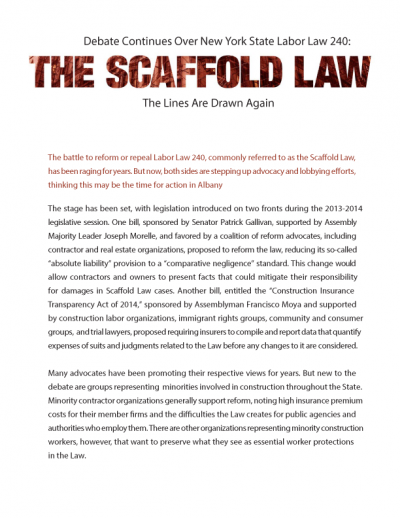
THE SCAFFOLD LAW
IS IT ALL ABOUT MONEY?
Simply put, reformers argue, higher insurance costs necessitated by New York's Scaffold Law mean less construction activity in all sectors. It means less money for roads, SUNY facilities, and other worthwhile construction projects sponsored by State agencies. In New York City, it means fewer classrooms and less money for improvements to all manner of public facilities. In the private sector, it means it is harder to make the numbers work and, consequently, fewer deals get done, fewer housing units are built, and fewer office towers, hotels, and expansions break ground. Or, if the jobs do move ahead, they may be scaled back, use non-union labor, feature less creative architecture, or include fewer amenities to contain costs. In the private sector, added project costs driven by the Scaffold Law have been cited by developers as a leading contributor to the unprecedented level of non-union construction taking place in New York City, as developers struggle to make the financials of a project viable in New York's extreme liability climate.
At Willis, Mr. Gunn and his colleagues broker insurance for clients throughout the country and have firsthand knowledge of the varying insurance costs in other states. Mr. Gunn said that, in general, insurance costs run five percent of project costs in 49 states, but run 10 percent in New York State. Picking one example, he compared Massachusetts, where insurance costs run two percent of construction value.
A Crain's New York Business article on the issue quotes AIG Property Casualty data that says historic insurance rates for New York City projects were three to four percent and have risen to eight percent or more (Insurance Hikes Hit Builders, November 25, 2012). It also shows Port Authority of New York & New Jersey figures of $10.3 million for George Washington Bridge work on the New Jersey side and $22.7 million for similar work on the New York side.
According to the Lawsuit Reform Alliance of New York's "Quick Facts," "New York's general liability insurance costs are between 300 percent and 1,200 percent higher than other states because of the Scaffold Law," and, "The Scaffold Law adds about $10,000 to the cost of the average home" (www.nylawsuitreform.org). Joseph Russo of insurance broker Aon cautions, "While legislative reform is needed to bring a component of comparative negligence to bear, it will not result in a radical or immediate decrease in construction insurance premiums" until judges are appointed to the New York State Court of Appeals who are willing to impose a stricter interpretation of the Law.
Evidence the Scaffold Law is hurting New York mounted further with the release in March of a report by the Center for an Urban Future entitled Caution Ahead; Overdue Investments for New York's Aging Infrastructure. The report advocates repeal of the Law among its recommendations for reducing infrastructure costs.
Albany elected officials should repeal the nation's last remaining Scaffold Law, which significantly inflates insurance costs compared to other states. The Scaffold Law holds builders responsible for "elevation related" injuries regardless of fault. Determining compensation based on comparative liability, as is done in most other states across the country, could save agencies like the School Construction Authority tens of millions of dollars in insurance premiums every year (page 60).



